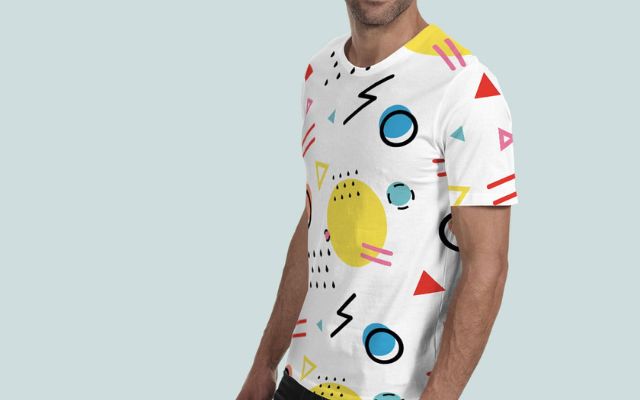Using custom print designs to customize your own mugs, t-shirts, and accessories are quickly gaining traction.
Whether it’s for expressing your love for a certain someone or starting a profitable business, sublimation printing enables you to print your designs on fabric and ceramics.
Sublimation isn’t as confusing or complex as it may sound.
In this post, we’ll explain what sublimation is, how sublimation printing works, and look at some examples to help you get started.
What is Sublimation Printing?
Sublimation printing is the process of taking a printed design and transferring it to an object through heat and pressure.
Scientifically, sublimation is the process of changing a solid particle into a gaseous state. In printing, it refers to the sublimation of ink particles that the print is formed by.
This method of printing has become a popular way of personalizing products. It can be used to create custom merch, clothing, and personalized gifts.
How Does Sublimation Printing Work?
Getting familiar with the sublimation printing process is important to make sure you don’t waste time and money. Fortunately, sublimation printing is fairly easy once you get the hang of it!
Sublimation Printing Process
There are a few steps in the sublimation printing process. These steps can be broken down as:
- Creating the design
- Printing the design
- Transferring the design
Keep reading for a detailed explanation of each of the steps.
1. Creating the Design
To get started, you need to create the design which you plan on printing.
This design needs to be created on a computer using a graphic design software.
CorelDRAW Graphics Suite is one of the best graphic design software for sublimation printing. You can get started for free with their 15-day trial.
For a free option you can even use Canva to create a design.
This tutorial from DIY Alex explains in detail how to create a design for sublimation in Canva, guiding you along the way:
After creating your design, you need to save it in a format your printer can read. We suggest you save it in PDF format for the best results.
Industry-standard tools like Adobe Illustrator or CorelDraw give you more control over your designs. You can export them in a higher quality and also view bleed and printer marks for a precise print.
If you’re a small business that operates more than one printer at a time, then investing in RIP software would be better. RIP or raster image processing software converts vector images into raster images that the printer can read. This leads to better print quality, a smoother print workflow, and gives you the ability to color correct images before printing.
2. Printing the Design
Once your design is ready, it’s time to print it.
To print the design you would need the following:
- Sublimation printer for transferring the design on to paper
- Sublimation ink to form the print design
- Sublimation paper to ensure a proper transfer of the design to another material
You can’t use any printer for sublimation printing so you would have to invest in a good-quality sublimation printer. Top printer brands that are capable of sublimation include Epson, Sawgrass, and Mitsubishi.
Next, you’d also have to buy sublimation ink cartridges as other types of ink may not be suitable for sublimation.
Finally is the type of paper you use for heat-transfer. Although you could use any paper to print your design, for it to efficiently stick to the material through a heat press, you would need to use sublimation paper. This is a special type of coated paper that can withstand the heat from the heat press.
3. Transferring the Design
After printing your design, you take the object you want to print it to and stick it on it with a heat press.
A heat press is a machine that applies heat and pressure to an object. To transfer your design onto an object you will wrap your paper around it and put it in the heat press. The heat will turn the liquid ink into gas form and by applying pressure, the design will stick to the material.
Having a heat press is necessary for transferring your designs to another object. Keep in mind that a heat press is probably the most expensive piece of equipment you’ll be investing in.
What is the Difference Between Sublimation Printing and Regular Printing?
Sublimation printing uses sublimation ink which is a special kind of ink that sublimates easily. A regular printer like an inkjet printer sprays tiny droplets of ink to form the image.
The ink used in regular printers isn’t suitable for sublimation and cannot be transferred to an object through a heat press. If you try to do so, it’ll damage the paper or tamper the design.
Regular printing is best for printing documents, graphics, and other paper-based material. If you want to print your design and transfer it to some plastic, ceramic, or fabric, then sublimation printing would be better.
Advantages and Disadvantages of Sublimation Printing
Sublimation printers can’t be used for every task which is why it has some pros and cons.
Advantages of Sublimation Printing
- Can be used on a variety of materials including ceramic, fabric, and plastic
- It’s easy to learn and use
- Inexpensive way of producing high-volume custom print designs
- Includes a wide range of colors to print with
- Long-lasting designs that permanently stick and don’t wash away, fade, or crack
Disadvantages of Sublimation Printing
- Can only print on fabrics that are made with 100% or 2/3 polyester
- Low-quality on inaccurate prints on black or dark-colored materials
- Might get clogged due to inactivity
- Design issues such as ghosting, white creases, and color mismatch
Examples of Sublimation Printing
Sublimation printing is a versatile method of producing a range of creative designs. Below are just some of the ways you can use sublimation printing.
Sublimation Printing on Fabric

If you have a sublimation printer and a bunch of clothes lying around, you can start customizing your t-shirt with sublimation printing.
When using sublimation printing on fabric, you should have a good idea of the types of material that are suitable with sublimation. These are:
- Polycotton textile
- Polymer
- Polyester
- Polyester-made fabric
Sublimation printing does not work on fabrics made from 100% cotton material. This is because these fabrics don’t absorb the ink from the printer due to their non-porous surface.
Sublimation Printing on Mugs

Creating personalized mugs to sell as merchandise or give as a gift to someone can be a great way of using sublimation printing.
When it comes to sublimating mugs, there aren’t any restrictions. You can sublimate any type of drinkware including mugs, sports bottles, and glasses.
Also, when sublimating your design on ceramic mugs you don’t need to worry about washing or microwaving the mug as the design won’t peel off.
Sublimation printing is much better than vinyl designs as you’ll need to use adhesive vinyl to ensure the design doesn’t peel over time.
Sublimation Printing on Shirts

Sublimation shirt printing involves printing a design onto a sheet of paper and then embedding that design onto a shirt using a heat press.
The main difference between sublimation shirt printing and other objects is that the type of fabric and heat press needs to be considered.
Since heat presses vary in size, you would need to buy one that can manage the size of the shirt. These are generally more expensive and less portable than a small heat press designed specifically for home use.
Frequently Asked Questions
Can Any Printer Do Sublimation?
No, any printer cannot do sublimation. There are specific printers made for sublimation that use sublimation ink to print designs that can later be transferred to another object usign heat and pressure.
However, it’s possible to convert a regular printer to sublimation by using sublimation ink. Printers that have a Micro Piezo printing head can be used for sublimation printing but most other printers use a thermal printing head for printing.
Is Sublimation Better than Heat-transfer?
Sublimation printing is better than heat-transfer when it comes to the durability and feel of the design on top of a material. By using heat-transfer, you print a layer on top of the object which you can feel as you brush your hand across it.
With sublimation, the design is permanently embedded into the material to the point you can’t feel it as a separate design.
Do Sublimation Printers Need Ink?
Yes, sublimation printers need sublimation ink to print the design on paper. This ink is unique from other types of ink as it turns from a solid into a gaseous state after being heated.
Do I Need a Computer for Sublimation?
Yes, you do need a computer for sublimation to create the design to be printed and applied onto another object.